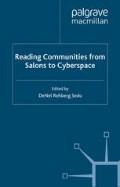Abstract
The particular scene of reading examined in this first chapter is that of the Bluestocking network of the second half of the eighteenth century in Britain; more broadly, the study of this reading group invites consideration of sociable reading as mediated across physical absence, the dialogic creation of reader identities, and the negotiation of cultural norms — issues central to the study of collaborative reading across temporal and geographical boundaries. The principal Bluestocking hostesses, Elizabeth Montagu (1718–1800), Elizabeth Vesey (1715?–91), and Frances Boscawen (1719–1805), established their gatherings in London in the 1750s; this movement attained the height of its popularity and cultural power in the 1770s, but continued with a second generation of hostesses and groups into the 1780s and 1790s. Characterized by a focus on rational conversation in explicit opposition to ‘superficial’ amusements such as card playing, the Bluestocking circles brought together wealthy and professional-class women (and men) of intellectual tastes, Anglican religious practice, and broadly conservative social views.
Access this chapter
Tax calculation will be finalised at checkout
Purchases are for personal use only
Preview
Unable to display preview. Download preview PDF.
Notes
1. Gary Kelly, ‘Bluestocking Feminism and Writing in Context’, in Bluestocking Feminism: Writings of the Bluestocking Circle, 1738–1785, 6 vols, gen. ed. Gary Kelly (London: Pickering and Chatto, 1999), 1.ix–liv; Harriet Guest, Small Change: Women, Learning, Patriotism, 1750–1810 (Chicago: University of Chicago Press, 2000), especially 13–17.
2. John Duncombe, The Feminiad (London: Cooper, 1754), 23.
3. Jan Fergus’s important study of Provincial Readers in Eighteenth-Century England (Oxford: Oxford University Press, 2006) has demonstrated empirically that many of these eighteenth-century assumptions about women’s reading, particularly the view that women were the principal readers of novels, are inaccurate.
4. For discussions of the importance of social reading in eighteenth-century English culture, see Patricia Howell Michaelson, Speaking Volumes: Reading and Speech in the Age of Johnson (Stanford: Stanford University Press, 2002), and Naomi Tadmor, ‘“In the Even my Wife Read to Me”: Women, Reading and Household Life in the Eighteenth Century’, in The Practice and Representation of Reading in England, ed. James Raven, Helen Small and Naomi Tadmor (Cambridge: Cambridge University Press, 1996), 162–74.
5. Terry Lovell, ‘Subjective Powers? Consumption, the Reading Public, and Domestic Woman in Early Eighteenth-Century England’, in The Consumption of Culture 1600–1800: Image, Object, Text, ed. Ann Bermingham and John Brewer (New York: Routledge, 1997), 37.
9. Elizabeth Eger’s Bluestockings: Women of Reason from Enlightenment to Romanticism (Basingstoke and New York: Palgrave Macmillan, 2010), ch. 2, details the influence of the Bluestockings as patrons, while Fergus’s Provincial Readers presents a careful and convincingly documented case for the predominance of the aristocratic, gentry, and professional classes in mid- eighteenth-century book consumption.
10. See Lars E. Troide and Stewart J. Cooke, eds, The Early Journals and Letters of Fanny Burney, Vol. 3 (Montreal and Kingston: McGill-Queen’s University Press, 1994), 347 n.74 for a summary of the likely reasons for suppression. For a media-centred approach to the cultural power of the Bluestocking women’s conversational and scribal practices see my chapter, ‘Bluestocking Women and the Negotiation of Oral, Manuscript, and Print Cultures’, in The History of British Women’s Writing, 1750–1830, ed. Jacqueline M. Labbe (Basingstoke: Palgrave Macmillan, 2010), 63–83.
14. John Brewer, ‘Reconstructing the Reader: Prescriptions, Texts, and Strategies in Anna Larpent’s Reading’, in The Practice and Representation of Reading in England, ed. James Raven, Helen Small and Naomi Tadmor (Cambridge: Cambridge University Press, 1996), 226–45.
17. Betty Rizzo, Introduction to The History of Sir George Ellison (Lexington: University Press of Kentucky, 1996), xix.
21. Elizabeth Montagu, ‘Dialogue III’, in Women Critics, 1660–1820: an Anthology, ed. by the Folger Collective on Early Women Critics (Bloomington and Indianapolis: Indiana University Press, 1995), 102.
22. Brean S. Hammond, Professional Imaginative Writing in England, 1670–1740: ‘Hackney for Bread’ (Oxford: Clarendon, 1997), 8.
24. Montagu Pennington, Memoirs of the Life of Mrs. Elizabeth Carter, with a New Edition of Her Poems (London: Rivington, 1808), 1.448.
Editor information
Copyright information
© 2011 Betty A. Schellenberg
About this chapter
Cite this chapter
Schellenberg, B.A. (2011). Reading in an Epistolary Community in Eighteenth-Century England. In: Sedo, D.R. (eds) Reading Communities from Salons to Cyberspace. Palgrave Macmillan, London. https://doi.org/10.1057/9780230308848_2
Download citation
DOI: https://doi.org/10.1057/9780230308848_2
Publisher Name: Palgrave Macmillan, London
Print ISBN: 978-1-349-33555-8
Online ISBN: 978-0-230-30884-8
eBook Packages: Palgrave Language & Linguistics CollectionEducation (R0)

